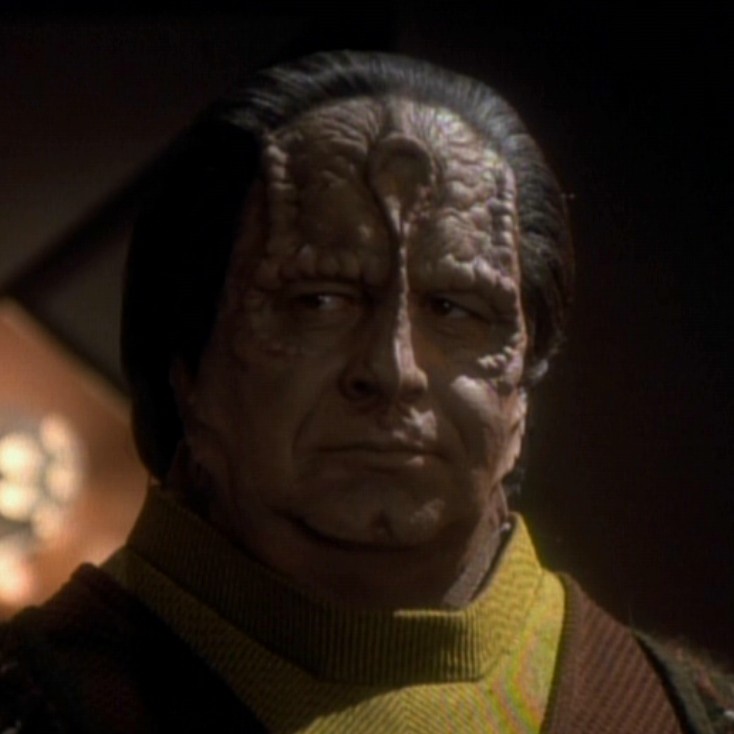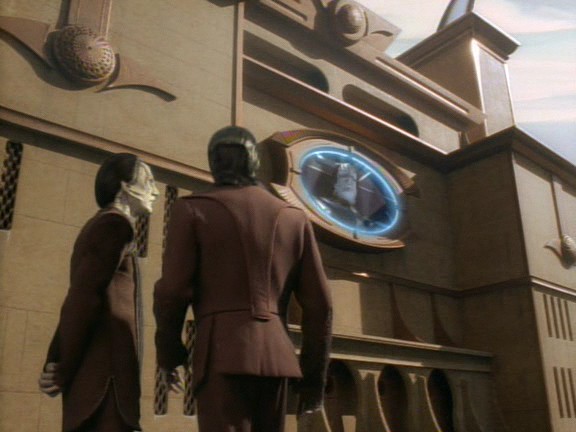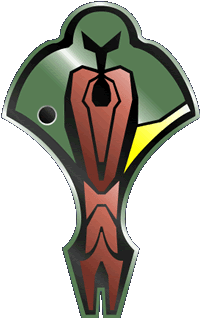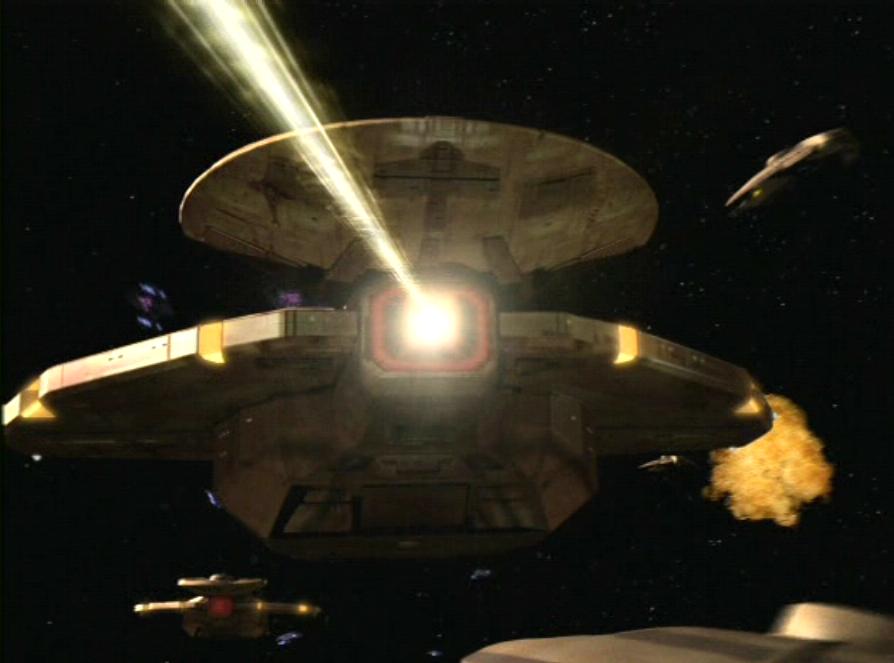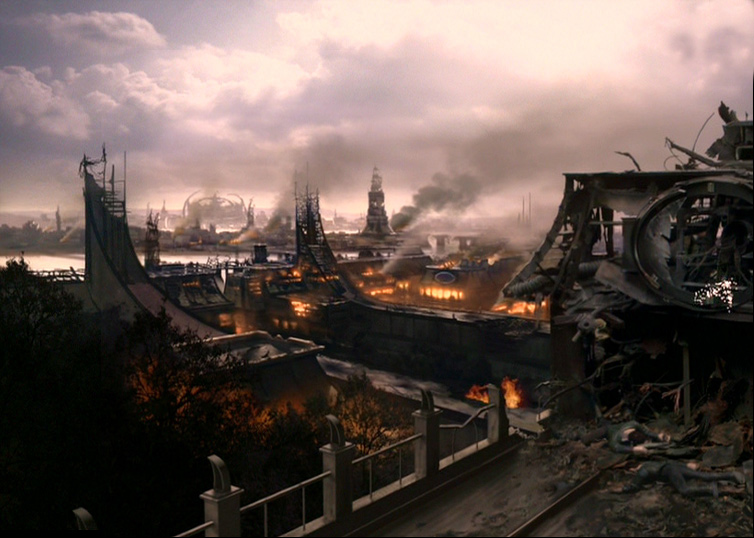Cardassian
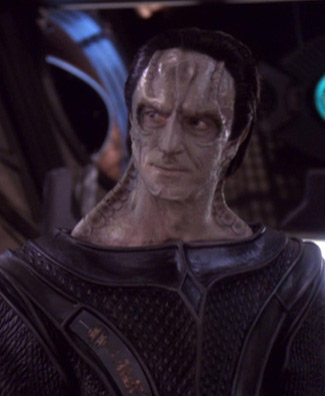
| |
| Cardassian | |
| Survey Data | |
| Star System: | |
| Region: |
Cardassian Space |
| Quadrant: | |
| First Contact: |
pre-2245 |
| Political Information | |
| Affiliation: | |
| Capital: | |
| Political System: |
Representative Democracy |
| Biological Information | |
| Type: |
Reptilian humanoid |
| Atmosphere type: |
Class-M, hot |
| Development Stage: |
Warp capable |
| Character: |
Disciplined, Prideful, Ruthless, Efficient |
| Number of Eyes: |
2 |
| [ Source ] | |
The Cardassians are a quasi-reptilian humanoid species native to the planet Cardassia Prime in the Alpha Quadrant, capital world of the Cardassian Union. In their native language, "Cardassian" means "People of Discipline".
As a generally militaristic race, they were known throughout the Alpha Quadrant for their ruthlessness, and the Cardassians became one of the greatest enemies of the United Federation of Planets and Klingon Empire when they joined the Dominion in 2373. Their xenophobic attitude towards other species was well established throughout the quadrant after the Setlik III massacre during the Cardassian War, as well as when their atrocities during the Occupation of Bajor were revealed after their withdrawal in 2369.
The democratic Reunionist political party later arose to power during the reconstruction process, reinstating the authority of the Cardassian civilian body known as the Detapa Council, with the more authoritarian Directorate assuming their role in the political process as an opposition party.
Contents
Physiology
The Cardassians appear to have evolved from a creature with both reptilian and mammalian traits, and it is known that their evolution, like many other humanoids, was influenced by the beings known only as the Ancient humanoids.
Standing roughly 1.8 meters (5ft 11in) tall on average, Cardassians tend to possess grey or grey-green skin tones with shiny, black hair, though a minority possess varying dark shades of brown. Members of the race are typically barrel-chested and slightly heavier than humans; a result of Cardassia's thicker atmosphere and slightly higher gravity. Elongated vertebrae covered in scaly plate sections extend along the sides of their necks. Segmented brow ridges extend down from the forehead and encircle their eyes. The ridge is thickest immediately above the eyes, protecting them and creating an especially deep-set appearance. An unsegmented ridge known as a chufa extends upward from the tip of the nose to an inverted tear-shaped protrusion in the centre of the forehead. This inverted tear shape is also mimicked at the centre of the Cardassian chest, roughly where the breastbone would be on a human. Their thick skins and tough bodies allow Cardassians to tolerate pain better than most other species, granting them a higher pain threshold than many softer-skinned species. Cardassians prefer a darker, hotter and more humid environment than humans.
The head and torso has an array of prominent ridges which are of cartilage construction and evolved as a defence against predatory attack. These ridges grow more prominent as young Cardassians develop through adolescence. Cardassians are a reptilian species but also have many features common to mammals; their skin is only scaled around their ridges and females have breast-like protrusions on their chests. Male Cardassians typically slick their hair back against their skulls, while females have more varying hairstyles. As with humans, Cardassian hair turned white with age, though some Cardassians - particularly males - tended to dye it instead of letting it show white, though this was more often an act of vanity rather than to prevent a show of weakness, considering the Cardassian's respect of the wisdom that comes with old age. Unbetrothed Cardassian females have a cosmetic blue colouration on the dip of skin between ridges on their foreheads and at the centre of the chest. This blue colouration was also sometimes applied to the second or third scale down on their neck ridges.
A Cardassian's neck ridges, though protected by a thick set of scales, are known to stimulate pleasure when massaged, as the muscles underneath are most prone to knotting when under stress. Though Cardassian hearing is not as acute as that of a Human, Cardassians are renowned for their photographic memories, which are harnessed through training from a young age, as is the ability to shield ones mind from mentally invasive techniques such as a Vulcan mind meld. Though as this technique was a learned skill and not a racial trait, it was not always effective, and depended greatly upon the individual's devotion, strength of will and concentration, and many non-touch telepaths such as Betazoids were frequently able to read a Cardassian's thoughts or emotions when they weren't actively focussing on blocking the contact.
Like many humanoid species, Cardassians were able to produce offspring with a variety of species, including Bajorans and Humans. Similarly to Klingon cross-pairing, Cardassian genes typically remained dominant for many generations, and although the features would appear reduced in hybrid offspring, Cardassian traits such as pale skin and their multitude of protective ridges would remain prevalent.
Medical Conditions
- Calebrian plague
- Coleibric Hemorrhage
- Kalla-Nohra Syndrome
- Pottrik Syndrome
- Rudellian plague
- Tzeka fever
- Viper's eye
- Yarim Fel Syndrome
Society and culture
Cardassian culture is hierarchical, with the State at the top in public life, and parents within the home. Cardassian architecture often reinforces established hierarchy by placing important individuals in physically high locations. The emphasis on hierarchy coupled with other factors are fertile ground for intense rivalries between individuals and families. As a result Cardassians are generally suspicious, and regard those who were not as foolish. Though Cardassians have compassion for those who are suffering, ultimately their actions are determined by what would serve the greater whole.
Unlike Humans, Cardassians do not fear old age and in fact respect the wisdom and dignity such a position granted to the Cardassian in question, and advanced age is a sign of great dignity. Cardassians respect authority and age, usually equating the two. A junior will often attach himself to an up-and-coming superior or already successful elder, assisting his chosen mentor in any number of tasks intended to further their career, and presumably furthering his own, as well. This can be dangerous, however, as should the mentor's fortunes turn, the apprentice makes a convenient individual on which to blame everything.
The older a Cardassian, the more feared they are because they are likely to know many secrets and maintain an extensive, and hidden, web of connections.
Cardassian culture values family highly as shown in the Cardassian saying "Family is all." Cardassian homes are typically multi-generational and hierarchical, with male and female parents sharing authority. Cardassian culture emphasizes family loyalty, though whether family loyalty trumps loyalty to the state remains to be seen. Similar to some other cultures, Cardassians place great value on the continuation of family lines, and as such are pro-natalist, though they are not known for having large numbers of offspring. In contrast to the close knit family unit, Cardassian culture does not regard orphans highly, and provides no obvious means of social welfare for them, though adoption is not unheard of. When making a speech, the leader of the Cardassian Union typically uses the send-off "This I vow with my life's blood, for my sons; for all our sons."
Neither of the two Cardassian genders is considered universally dominant over the other, though each tends to be dominant within certain specific fields within their society. Patrician Cardassian males lead a life focused on military and political service, and thus societal advances in technology and engineering have always been spearheaded by Cardassian females. Most Cardassian scientists tend to be females, and in Cardassian society the sciences are widely known to be dominated by females. This does not mean that women are relegated to maintaining the Cardassian technological base, as various female ship commanders and political leaders have been known to serve.
Cardassians enjoy debate and conversation in general. Cardassian meal time is as much about discussion as it is about eating. They will speak at length about a topic to show their knowledge, avoid saying something incriminating, or to obtain some piece of information from the person they are speaking to. Such is their love of conversation that it plays a major role in their courtship. Courtship among Cardassians largely consists of bitter, ferocious arguing. Pressing the palm of one's hand to another's palm was the equivalent of a kiss on the cheek.
The Cardassian design ethic shows a preference for dark colours. Their architecture tends to have things in sets of three, and to have a sense of symmetry. Designs favour trapezoids instead of squares, and ovals instead of circles, though Cardassian engineering standards are usually lower than Starfleet's, with Cardassian specifications often accepting operating efficiency levels within as much as 20%.
Cardassians are meticulous record keepers using well-organized files and databases. They have instructed many other worlds, including Bajor, in their archival methods. Much like minions of the Dominion, Cardassians are known for their punctuality. Cardassians also greatly value efficiency; Cardassian mines before the fall of the Dominion were almost always on class-M worlds, as the expense of excavating in other non-native environments was not considered to be cost effective.
Cardassians have been known to be similar to the Romulans in their xenophobic tendencies, and also share the Romulan belief that there is no such thing as luck. Like the Breen, they treat their prisoners with little tolerance or sympathy, and have no qualms with using torture to extract information. Additionally, they are similar to the Ferengi in that they are well known for paying their bills and being great admirers of wealth and opulence. During the Cardassian's occupation of Bajor, many officers accepted bribes to overlook suspicious activities, for additional food, or for other "favours." To many Alpha Quadrant species, Cardassians have been seen as nothing more than arrogant, cruel, cold-blooded killers.
Education
Cardassians consider their educational system to be unparalleled in the Alpha Quadrant, and educational attainment is regarded as a key asset in Cardassian society. Cardassian children are often put into intensive mind training programs from as early as three or four. It is because of these mind training programs that many Cardassians are able to resist mentally invasive techniques such as a Vulcan mind meld. Cardassians are also trained during this time to have photographic memories. A typical view of how children should be raised has been summed up in a fairly common Cardassian saying: "Education is power... joy is vulnerability."
Religion & Beliefs
The early Hebitian people were deeply religious and exhibited vibrant religious practices, but the ages of hardship on Cardassia with resource shortages, famine and rampant plague would shift the Cardassian people to a more militaristic and expansionist view in order to survive. As such, the concept of religious beliefs was replaced by a patriotic duty in the state itself, with the Cardassian society embracing a totalitarian police-state which would be strong enough to provide for the material needs of its citizens. This results in many Cardassians being extremely loyal to their government, which is seen as being omniscient, omnipotent and benevolent. As the ancient religion was a deviation from utter devotion to the government, the modern Cardassian Union was founded as a non-theistic society where loyalty to the State achieved profound importance.
Modern Cardassians seem to regard the religions of other galactic species as anachronistic or backward as evidenced by their actions during the Bajoran Occupation, though extenuating circumstances may have played a role in this. During the period in which Cardassia was a member of the Dominion in 2373, most Cardassians did not view the Founders as deities, instead focusing on their physical properties as Shapeshifters. Cardassians do not believe in luck; rather that all outcomes are ultimately determined by the individual's strength or will.
Modern Cardassians exhibit involved funeral practices. Funeral services are open to the entire Cardassian public, especially for memorable figures in politics, the military and the arts alike. Cardassian graves are believed to be only in ground burials, and are marked, especially those of high ranking or famous people, such as war heroes or great scientists, with monuments of varying degrees of ornamentation and size. Cardassians consider viewing of their corpses by non-Cardassians as taboo. A unique aspect of Cardassian burial practice is known as Shri-tal, when a dying family member passes on all their secrets to their surviving relatives so they can use them against the dying one's enemies.
Philosophy
The ideal Cardassian life is one of complete loyalty and servitude to the State. The Cardassian government is assumed to be omniscient, omnipotent, and benevolent. In a sense, when the Cardassians abandoned their spiritual ways and began their expansion throughout the Alpha Quadrant centuries ago, they simply applied a twisted form of their religion to their political philosophy.
A typical example of the Cardassian approach to life is found in their jurisprudence and criminal trials, in which the verdict was always determined beforehand - guilty - and the purpose of the proceedings was not justice in the Human sense but bringing the offender to recognize the power and benevolence of the State. A trial, therefore, is an opportunity for the state to reveal how someone's guilt is proven by what they considered "the most efficient criminal investigation system in the quadrant". Consequently, charges against the accused are announced at the commencement of the trial itself, the execution date is set in advance and only the offender's spouse as well as the court-assigned nestor and counsel can attend the trial. Cardassians have described the reasoning behind this phenomenon as being that the public enjoy watching "justice triumph over evil". The notion that they might try an innocent man by mistake was foreign to the Cardassian people as they believed in and always operated under the assumption that "Cardassians don't make mistakes", though this stance has been shaken many times since the 2370s. The typical Cardassian approach, therefore, has always been direct, simple, and ruthless, uncaring about how many aliens – or Cardassians – were trampled in the interests of the state.
Cardassians pride themselves on their attention to detail and memories. They have no interest in science for its own worth, and demand that scientific projects, like everything, serve military benefits.
The Cardassians often view themselves as superior to other species and cultures. This belief was summed up by Dukat when he announced Cardassia's membership in the Dominion saying, "The Dominion recognizes us for what we are... the true leaders of the Alpha Quadrant." The Cardassians were particularly adamant that the Bajorans were a weak and inferior race, and that the Cardassians were victims to terrorist attacks while they were attempting to "uplift" the Bajoran people. This went as far as some Cardassians claiming that the Bajoran race was genetically inferior, though such views have been either largely abandoned or are simply no longer voiced after the Bajorans' large part in assisting the Federation to defeat the Dominion.
Cardassian philosophy typically upholds the idea that the ends justify the means. After unearthing the burial vaults of their ancestors, which were filled with rare artifacts, they sold them to other species to pay for their war efforts as well as to feed the starving population on the homeworld. Additionally, the extraction of Bajor's natural resources was considered an appropriate means to feed Cardassia's population, despite the fact it required the occupation of the Bajoran's homeworld.
In the aftermath of the Dominion War, and the utter devastation it created for Cardassia, one of the greatest questions facing the Alpha Quadrant was whether Cardassia would remain entrenched in its old, bloody system or if a reform to a more Federation-style democracy was possible. Though such a reform has partially occurred, Cardassian philosophy is still very much rooted in its long-held beliefs, though tempered by Federation oversight and the lack of a means to attain the superiority the Cardassians once desired for their race.
Citizenry and the State
Cardassians gave their first molar to the Bureau of Identification at age ten.
Cardassian society has the most rigid and, to the Federation, incomprehensible of all legal systems. Every suspect is guilty before even appearing in court, their sentence already spelled out – almost always either death or imprisonment in a harsh labour camp. The criminal is given a Conservator, equivalent to a public defender, except that the Conservator is not supposed to win but to prepare the criminal for a moving confession of guilt on the floor of the court. The accused is also permitted an advocate, the Nestor, to advise them during the trial. The Chief Archon, or judge, of the court plays to a televised audience, their duty not to judge the prisoner's innocence or guilt, but rather to give an emphatic display of the futility of crime on Cardassia and reinforce the public's trust in the judicial system.
Government
- Main article: See Cardassian Union
The governing body of Cardassia is the Cardassian Union. The elected Detapa Council had ruled for centuries but, over the years, the Council's power was usurped by Cardassian Central Command, the military branch of the government, transforming Cardassia into a police state. By the late 24th century, the Central Command's control was slipping due to civilian protests and the Cardassian dissident movement. The Obsidian Order had been given limited autonomy and thus took a very active role in Cardassians' lives, but it was forbidden from raising an army and its autonomy could be revoked at any time.
The latter half of the century saw significant changes. A secret joint operation between the Obsidian Order and the Romulan Tal Shiar, intended to cripple the Dominion, raised an armada of ships armed with cloaking devices. The plan nearly succeeded but had been sabotaged by a Changeling infiltrator. The joint Cardassian-Romulan fleet was utterly destroyed at the Battle of the Omarion Nebula, and the staggering losses suffered by the Order combined with public outcry had caused its downfall.
Without the Obsidian Order to keep the populace in line, the dissident movement eventually succeeded in securing control of the government. A civilian uprising reinstated the power of the Detapa Council, but this drew the attention of the Klingon Empire. Claiming that the Detapa Council was replaced by Changelings, Chancellor Gowron and General Martok (who was himself under the influence of a Changeling infiltrator) initiated the Klingon-Cardassian War in a thinly veiled attempt to seize control of Cardassian territory. The invasion, combined with terrorist pressure from the Maquis in the Demilitarized Zone, resulted in utter chaos. In an attempt to restore Cardassia to its former glory, Gul Dukat secretly negotiated Cardassia's entry into the Dominion.
When Gul Dukat completed negotiations with the Dominion in 2373, the Detapa Council ceased to exist altogether, just as the Obsidian Order had two years prior. Placed as the leader of the Cardassian Union, Gul Dukat had control over the majority of Cardassian affairs. However, he was forced to work under the regulations of the Dominion. During the first three months of the Dominion War, Dukat generally controlled the Cardassian and Dominion fleets, with the Vorta Weyoun overseeing his decisions. Dukat was able to maintain an equal standing with Weyoun, though both were subjected to the unquestionable orders of the Founders.
After Dukat's breakdown into insanity due to the death of his daughter, Tora Ziyal, Damar was placed in command of the Cardassian people. Since the new leader lacked the self-confidence and leadership skills of his former mentor and predecessor, Weyoun was able to take more and more control over the Cardassian people, with Damar becoming little more than a figurehead. Eventually, Damar had absolutely no say in any political decisions. This became blatantly obvious when Weyoun made territorial concessions to the Breen in 2375 in order to convince them to join the Dominion. Eventually, the Cardassians rebelled under Damar's leadership near the end of the Dominion War, allowing the Federation Alliance to gain a decisive advantage during the Battle of Cardassia and eventually win the Dominion War.
The Cardassian Union was occupied by the Federation, Klingon Empire and Romulan Star Empire, and provided aid in order to rebuild and work towards becoming self-sufficient once more, though the Klingons and the Romulans argued for the annexation of the Union, and the Cardassian people becoming subject species of the three occupying powers - a move which the Federation did not allow. By 2376, the Detapa Council had been restored to power under the Reunionist political party, which advocated a representative democracy, with civilian oversight over the military, whilst the opposition power - known as the Directorate - desired a more authoritarian return to rule by Central Command, feeling that Cardassia's demise had begun when the dissident movement seized power from the military and placed it in the hands of the former Council.
History
- Main article: See Cardassian history
In its ancient history, before Cardassia became a military dictatorship, the Cardassian society was known as the Hebitians. It was home to fine art and beautiful architecture. Once the Hebitian civilization fell into decay from lack of natural resources, millions of Cardassians were starving and the planet was subjected to utter chaos. Though the Hebitian society and way of life eventually became extinct, the remaining Cardassians turned to the military to solve their problems. This began the Cardassian policy of expansion into the Milky Way Galaxy, to provide the much-needed natural resources to sustain its population. Cardassians were capable of interstellar travel by the middle of the 22nd century.
- See also: Occupation of Bajor
During the 24th century, Cardassians were involved in three cataclysmic wars. The first major war was with the Federation in the mid-24th century, which ended in a turbulent peace treaty. A second war broke out when the Klingon Empire launched an unprovoked and unjustified invasion into Cardassian territory after a successful rebellion had overthrown military rule. The Klingons believed the coup to be a result of Changeling infiltration, and therefore attempted to take over the Cardassian Union. The coup was in fact successful due to the collapse of the Obsidian Order after the Battle of the Omarion Nebula. This war devastated Cardassian infrastructure, with a great loss of life and territory.
The third and largest of these conflicts was the Dominion War. In order to drive out the Klingons from their territory, destroy the Maquis in the Demilitarized Zone and regain Cardassia's status in the Alpha Quadrant, Gul Dukat signed a treaty making Cardassia a member of the Dominion. Cardassian and Dominion forces proceeded to push the Klingon fleet out of Cardassian territory and wipe out the entire Maquis movement within a few days.
While initially the alliance with the Dominion seemed to be beneficial to Cardassia, in the long run it resulted in an exponential loss of life. Near the end of the Dominion War, Cardassia Prime was struck by Jem'Hadar raids and orbital bombardment from the Dominion and Breen forces in orbit of the planet, which attempted to wipe out the Cardassian species entirely for their betrayal. Over 800 million Cardassians were killed in a few short hours.



